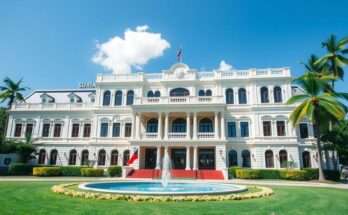The Museum of the Acrean Peoples in Rio Branco, Brazil, showcases the state’s rich cultural history, funded by the World Bank’s ProAcre project with a R$ 16 million investment. Opened in August 2023, it features diverse exhibitions, including significant paleontological finds like a Purussaurus fossil, and has attracted over 32,000 visitors by January 2025. The museum aims to enhance local pride and preserve cultural heritage.
The Museum of the Acrean Peoples, located in downtown Rio Branco, Brazil, documents the rich cultural heritage of the remote state of Acre, contrary to prevalent jokes questioning its existence. Established in August 2023, the museum features a significant collection, including a fossil of a Purussaurus, a gigantic ancestor of the caiman, providing insights into the region’s prehistoric life.
Funded by the World Bank, the museum was developed through the Acre Social and Economic Inclusion and Sustainable Development Project (ProAcre), which invested approximately R$ 16 million (USD 2.8 million) to repurpose an old school building into a prominent tourist site. The museum encompasses seven exhibition areas equipped with modern amenities, an auditorium, a café, and a souvenir shop, housing a variety of artifacts, artworks, and publications that contribute to cultural education and development.
Among the highlights of the museum are the Chico Mendes Room and a replication of a rubber tapper’s house, alongside the Personalities Room, which showcases prominent Acreans, including musician João Donato and novelist Glória Perez. Interactive elements, such as puzzles featuring local slang, further enrich the visitor experience. ProAcre’s initiatives aim to strengthen regional identity and pride in local heritage.
Constructed in 1952 as a boarding school for boys, the building has a storied past involving educational and cultural development. Under the leadership of Italian friar André Morini Ficarelli, it evolved from a school into a secular institution known as Meta, serving as a hub for student movements and cultural activities. Abandoned after its closure in 2005, the building was revitalized into a museum following government expropriation and renovation.
By January 2025, the museum is anticipated to welcome over 32,000 visitors, showcasing both indigenous heritage and the stories of those who migrated to Acre for opportunities. Its location enhances the vibrant cultural scene of the city’s historic center, featuring colorful homes and local establishments along the Branco River. Fatima Amazonas, project manager for ProAcre, emphasizes the enduring impact of these investments in enhancing local pride.
Notably, former Meta student Aline Albuquerque expressed her enthusiasm for the revitalized space, reminiscing about her school days. “After the school moved to another location, I never came back here. I am very happy that this space is being well utilized,” she remarked, highlighting the museum’s significance to the community.
The Museum of the Acrean Peoples stands as a testament to Acre’s rich historical and cultural legacy, providing a space of learning and reflection for locals and visitors alike. Supported by the World Bank through the ProAcre project, the museum not only conserves important artifacts but also fosters regional pride and identity. Its successful transformation from an abandoned school into a vibrant cultural institution illustrates the positive impact of investment in local heritage.
Original Source: www.worldbank.org




